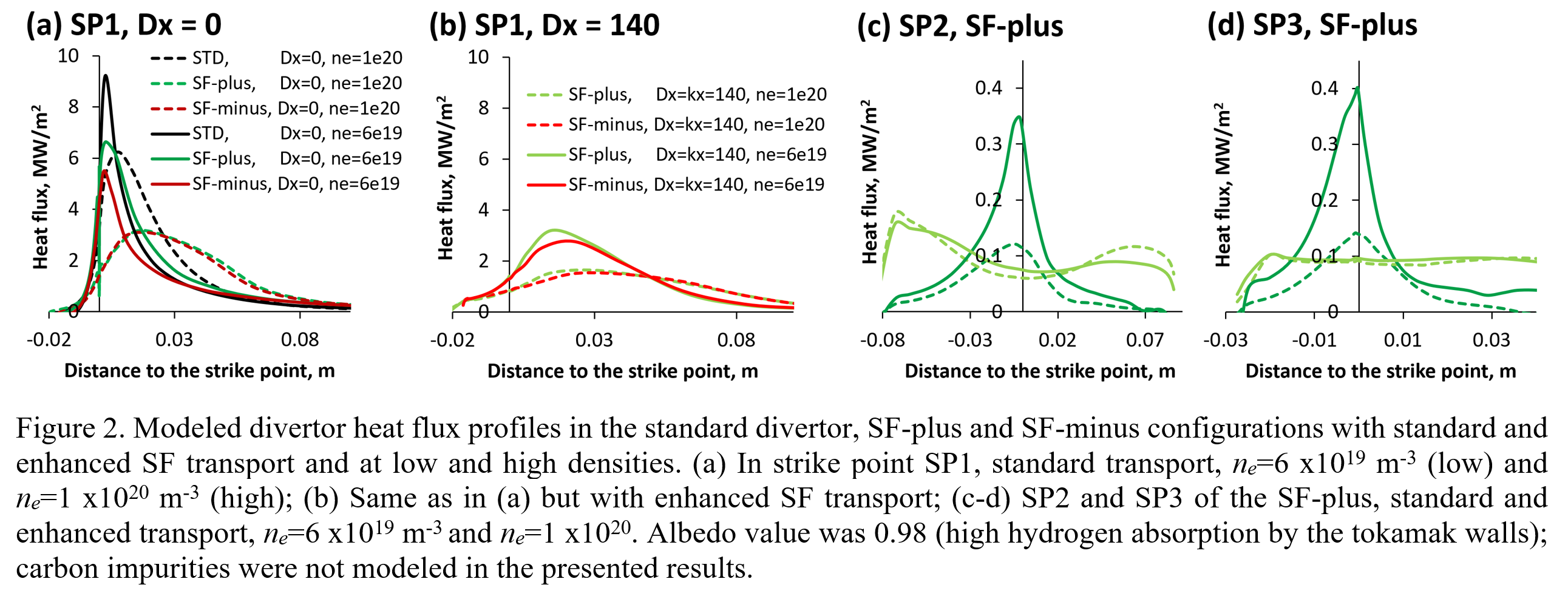Speaker
Description
Magnetic equilibrium modeling using the FIESTA code shows that steady-state snowflake (SF) divertor (1) configurations can be created and maintained with the existing poloidal field coil set in the MAST-U tokamak. A full multi-fluid plasma transport model with a computational grid encompassing two poloidal magnetic field nulls, with charge-state-resolved carbon impurities sputtered at material boundaries, and fast convective SF plasma transport (mixing) has been applied to the standard and SF divertor configurations using the UEDGE code. Results show that the SF divertor 1) reduces peak heat loads to divertor plates by spreading particles and heat fluxes to additional strike points; 2) the additional strike points receive up to 10% of heat and particle fluxes (w.r.t. the outer strike point), with weak dependence on two-dimensional profiles of particle diffusivities and heat conductivities as well as SF geometry details; 3) SF divertors approach the outer strike point detachment conditions at lower upstream density w.r.t. the standard divertor. Experiments are planned to validate the model, as part of a broad advanced divertor research program in MAST-U (2). The SF divertor uses two nearby 1st order nulls separated by distance $d_{xx}$, for a larger region of low poloidal field $B_p$ (PF) that modifies geometry and transport resulting in heat and particle flux sharing and reduction (1).
Snowflake magnetic equilibria created with a free-boundary Grad-Shafranov equilibrium code FIESTA using realistic currents $I ≤ 4 kA$ and existing MAST-U poloidal field coils show significantly increased near-separatrix connection length (cf. the standard divertor). A three-coil SF divertor algorithm previously developed in NSTX and DIII-D experiments (3) was used and improved with additional PF coils. Based on the theoretical SF criteria (1), families of up-down symmetric SF configurations were created (as, e.g., in Fig. 1) with $d_{xx} ≤ a (\lambda_q /a)^{1/3} = 0.15 m$, where $a=0.65 m$ – plasma minor radius, $\lambda_q$ ~ $8 mm$ – SOL heat flux width. The core kinetic profiles from the H-mode plasma model with modest shaping, $I_p=1 MA$ and $P_{NBI}=2.5 MW$, were used. Two main SF variants were investigated: the SF-plus configuration with a 2nd null in the private flux region (Fig. 1 (b)) and the SF-minus with a 2nd null in the low field side common flux region (Fig. 1 (c)). Flux tube connection length from outer midplane to outer strike points within 1-2 mm from the separatrix were up to 50% higher in both the SF-plus and SF-minus configurations (cf. standard divertor).
Two transport models in UEDGE were used over a broad range of core-boundary densities $2·10^{19} m^{-3}$ to $2·10^{20} m^{-3}$ . In the standard transport model, SOL ion diffusivity and heat conductivity profiles were taken to match the MAST-U SOLPS/EIRENE model (4). A second model emulated the theoretically predicted fast plasma mixing (the “churning” mode) in the two-null SF region (5). The churning mode convective zone radius was estimated to be $r* = 0.81 a(B_p a/R)^{1/3}$ ~ $10 cm$ for the SF divertor, and $r* = 0.44 B_pa^2/R < 1 cm$ for the standard divertor. The enhanced SF transport was modeled as Gaussian profiles with $r* = 10 cm$ centered at the nulls (Fig. 1 (d), (e)), with peak values $140 m^2/s$ (cf. $1 m^2/s-2 m^2/s$ in the standard transport model).
With the standard transport, peak heat fluxes at primary strike points SP1 and SP4 were 30-50% lower in the SF-plus and SF-minus configurations, cf. standard divertor. Heat flux profiles were considerably broader, due to diffusion into the secondary strike points and the increased connection length (Fig. 2 (a)). Primary strike point heat flux profiles in the SF-plus and SF-minus configurations with a small $d_{xx} = 2.5-3 cm$ were similar. Heat fluxes showed weak dependence on wall albedo $\alpha_w$ (hydrogen atom wall reflection). However, heat and particle fluxes to secondary strike points SP2 and SP3 were found to be rather sensitive to the albedo. With $\alpha_w=0.98$, additional strike points received heat and particle fluxes of about 5-10% of those in the outer strike point (Fig. 2 (c,d)), as compared to only 1-3% with $\alpha_w=1$.
As the core-boundary (upstream) plasma density ne was increased, primary strike points SP1 and SP4 in the SF divertors reached low temperatures (~ 1 eV) and low peak heat fluxes at lower ne than the standard divertor (Fig. 2 (a)).
A complex interplay of SOL geometry effects, transport, and magnetic configurations was observed with the enhanced SF transport. The additional plasma mixing led to spreading of ions over a wider divertor region thereby reducing peak ion and neutral densities (Fig. 1 (d-e)). Heat flux profiles in all strike points were broadened (Fig. 2 (b-d)), peak heat flues were reduced. At higher core density ($10^{20} m^{-3}$), heat fluxes to additional strike points SP2 and SP3 were increased. With the enhanced SF transport (mixing), small differences between SF configurations with various inter-null distance $d_{xx}=3-12cm$ were observed. Primary strike points SP1 and SP4 reached detachment conditions at lower core-boundary density ne than with the standard transport assumptions.
In summary, significant progress in numerical modeling of SF divertor configurations was made in preparation for MAST-U experiments. The results show that heat and particle fluxes were spread among additional strike points and reduced as compared to the standard divertor. The MAST-U modeling results are consistent with numerous findings in previous SF divertor experiments conducted in TCV, NSTX, and DIII-D tokamaks (1,3).
This work is supported by the US DOE under Contract DE-AC52-07NA27344 and the RCUK Energy Programme Grant Number EP/P012450/1 and EURATOM.
(1) D.D. Ryutov, Phys. Plasmas 14 (2007) 064502; Phys. Plasmas 22, 110901 (2015).
(2) J. R. Harrison et al. Nucl. Fusion 59 (2019) 112011
(3) V.A. Soukhanovskii et al., Phys. Plasmas 19 (2012) 082504; Nucl. Fusion 58 (2018) 036018
(4) Moulton D. et al 2017 Proc. 44th EPS Conf. (Belfast, UK, 2017)
(5) D. D. Ryutov et al., 2014 Phys. Scr. 89 088002; D. D. Ryutov D. et al., PPCF 54 (2012) 124050


| Affiliation | Lawrence Livermore National Laboratory |
|---|---|
| Country or International Organization | United States |
